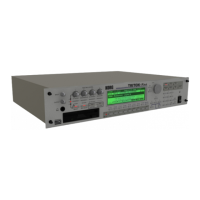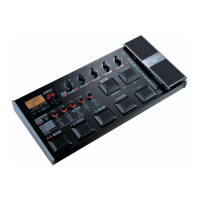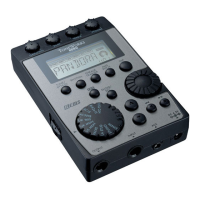1–1: Global Setup
133
For transmission, velocity curve 4 in the lower left graph is automatically used.
Curves
7
and
8
produce a steady level of effect for softly played notes, and are suitable for use
when you do not require velocity control or when you wish to even out the strength of notes, but
have the disadvantage that dynamic control of the softer notes is more difficult. In this way, each
curve has its own characteristics. Select a curve that is appropriate for your own playing strength,
playing style, and the effect that you are trying to produce.
1: significant effect is produced only for strongly played notes
2: similar to 1
3: similar to 1
4: playing dynamics allow control over the effect (the standard curve)
5: similar to 4
6: significant effect is produced even without playing strongly
7: medium-strength notes produce a fairly steady effect
8: medium-strength notes produce an even steadier effect than 7
Aftertouch (Aftertouch Curve) [1…8]
When using aftertouch to control volume or tone, the curve you select here will affect the relation
between the aftertouch pressure you apply and the resulting effect.
When “1–1b: Position” is set to Post KBD, the pressure you apply to the keyboard will produce the
aftertouch effect or transmit aftertouch data as shown in the graph below (left).
For received data, aftertouch curve 3 from the graph below (at right) is used automatically.
With a setting of Pre TG, the pressure you apply to the keyboard or the aftertouch data that is
received will produce an aftertouch effect as shown in the graph below (right)
For transmitted data, aftertouch curve 3 from the graph below (at left) is used automatically.
In curves
6
and
7
, the change takes place over 12 and 24 steps respectively. If you are recording
aftertouch data to the sequencer and want to avoid using excessive memory, you may wish to use
these curves (set Position to Post KBD). In particular, since curve 7 is in 12 steps, you could assign
aftertouch to modify the pitch and set the width of pitch change to 1 octave, so that aftertouch
would modify the pitch in semitone steps.
Curves
1
–
5
can be used when you wish to make fine adjustments.
Curve
8
is random, and can be used when you want to produce special effects, or when you want
to use aftertouch to apply irregular modulation.
1: significant effect is produced only for strong pressure
2: similar to 1
3: aftertouch allows the effect to be adjusted (normal curve)
4: similar to 3
5: effect is produced even with soft pressure
6: aftertouch adjusts the effect in large steps (24 levels)
7: aftertouch adjusts the effect in large steps (12 levels)
8: random
For Pre TG
Velocity (MIDI In→TG)
1
MAX
127
1
8
6
5
4
3
2
7
Soft
127
Strong
1
1
2
3
8
6
5
4
7
Velocity effect
For Post KBD
Velocity (KBD→MIDI Out)
3
4
5
7
2
1
6
For Post KBD
After Touch (KBD→MIDI Out)
Soft
127
Strong
0
8:RANDOM
1
For Pre TG
After Touch (MIDI In→TG)
0
MAX
127
3
4
5
7
2
6
8:RANDOM
Aftertouch
effect

